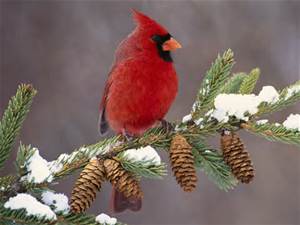I regretted being away from home when the call came. My daughter called laughing, “There’s a bird in our house. What do I do?” After instructions were given for shooing the feathered friend back to his habitat, I called back a few minutes later to check the status and inquired, “What kind of bird was it?” She said, “It was a cardinal, Mom.” Stunned, I hung up the phone. Stunned and pleased that this shy, quiet red bird came close enough to my door to enter, sit on the arm of my sofa, circle the room and exit gracefully.
For sixteen months I observed the movement of cardinals. I watched the rhythm of life outside my window move through the seasons while inside life stood still. Always, there would be a cardinal to cheer me, to offer solace and hope. Each time they would visit a tree branch or the feeder, some message would come forth and I would write my thoughts:
November 2007
There is a canvas outside our living room window that Fall has painted. The river birch leaves are the color of mustard and closer to the window a holly loaded with red berries. As Megan and I view our “painting” it comes to life with a bright red cardinal, working among the berries in the holly tree. I wish I knew more about birds, but I do know that the cardinal spends the winters here in Atlanta. Yesterday, there must have been 1000 birds overhead, fleeing for the winter. Other birds, like robins, sort of stay around, but hide themselves. I always felt bad for the robin, remembering the child’s verse, “The North Wind will blow, and we shall have snow, and what will the Robin do then – poor thing? He’ll sit in the barn, to keep himself warm, and hide his head under his wing – poor thing!”
Could the winter habits of birds be teaching me something about suffering? Warren Wiersbe says that in suffering we tend to fall into three categories of coping. We can escape – flee when the cold winds come. We can endure – hide ourselves under our wings – poor things! Or we can enlist – find an evergreen loaded with nourishment to shelter us from the storm. We, unlike birds, have a choice.
I will choose the cardinal this winter. Escaping is out of the question, enduring is drudgery, but enlisting is taking the winter on, finding the bright, red berries in the cold, singing when the wind blows cold, and trusting that Spring will certainly come. I am not surprised at wonderful and amazing God – He not only gives the wintering cardinal the instinct to nest in the protected denseness of the holly, but also provides food right outside the door of his nest and places it all for us to view. How much more does he provide for us? As the song says, “His eye is on the sparrow, and I know He watches me.”
For a cardinal to actually come into my house was, for me, a visit out of the ordinary. Maybe you have had such a visit. Others had those visits. Isaiah was visited by God’s counsel 700 years before the birth of Jesus. He must have been so profoundly moved by his vision he wrote in Isaiah 9:6, “For a child has been born for us.” Mary, Joseph, the shepherds, and wise men all had visits out of the ordinary. But the smallest visit to earth was Jesus himself – a tiny, out-of-the-ordinary child who came for us. And He still calls us today, saying, “Listen! I am standing at the door, knocking; if you hear my voice and open the door, I will come in to you and eat with you, and you with me.” Revelation 3:20
Dear God, I open my door today with hope – even in the cold – and invite you in.


Marcia! What beauty. Depth, wonderfully spoken to open our doors to the kindness and love of our unexpected God visits. Thank you for this clarion call. It blesses my day….and the days of countless others, I am sure. You are a blessing. I love you, M
I am so awe inspired with your beautiful advent reflections. I recall this specific one about the birds …2007.
remembering with new insight…..
A cardinal has never been the the same to me since your 2007 writing. Thank you, my friend, for painting the picture.
And you were the first person I thought of when I re-posted. Much love and looking forward to the 17th with you!
My sister comes as a Cardinal . How can I sigh up for your daily devotional
Thank you,Hope! At the bottom of the blogpost or along the side, there should be a button that says “follow” or “subscribe” You click on that and it will prompt you to leave your email and you should receive it. If not, email me at marciagaddis@gmail.com.
Blessings!